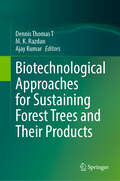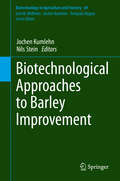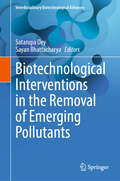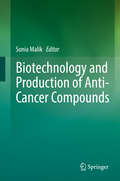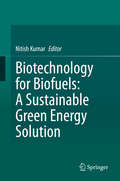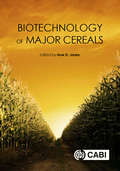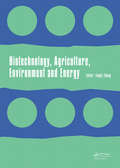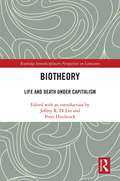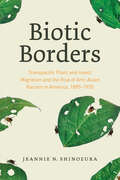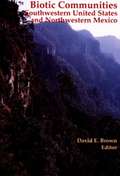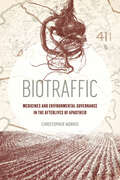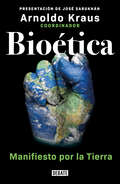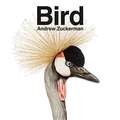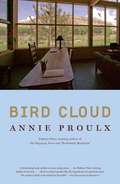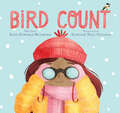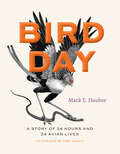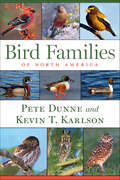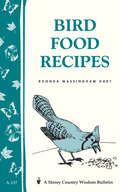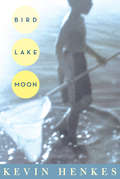- Table View
- List View
Biotechnological Approaches for Sustaining Forest Trees and Their Products
by Ajay Kumar M. K. Razdan Dennis Thomas TThis edited book gives an in-depth coverage of various aspects of biotechnological procedures followed by international scientists and researchers to sustain growth and improvement of forests in context of current climatic change. Forests especially trees play a crucial role in maintaining the ecological balance as well as in the functioning of natural ecosystem. More importantly, they contribute to the economic growth of a country through its products such as timber, fuel, pharmaceuticals, fibre for textile industry and edible fruits. The denudation of trees due to urbanisation of towns/cities/villages by various construction activities and industrialisation directly impact the climate change resulting in global warming, short rainfall or erroneous weather currently experienced. This book is an effort to address these problems and attempts to find out solutions using biotechnological approaches. Most of the proposed chapters cover latest information. The proposed book deals with biotechnological aspects of forest trees such as micropropagation, somatic embryogenesis, somaclonal variation, synthetic seeds, cryopreservation, disease amangement and genetic engineering. Further, applications and limitations of these approaches to improve the forest trees are discussed. The book is of relevance to teachers, students and researchers working in area of forest and plant biotechnology globally.
Biotechnological Approaches to Barley Improvement (Biotechnology in Agriculture and Forestry #69)
by Jochen Kumlehn Nils SteinThis volume offers an up-to-date overview of biotechnologically oriented barley research. It is structured into two major sections: the first focusing on current agricultural challenges and approaches to barley improvement, and the second providing insights into recent advances in methodology. Leading scientists highlight topics such as: the global importance of barley; genetic diversity and genebanks; domestication; shoot and inflorescence architecture; reproductive development; mineral nutrition; photosynthesis and leaf senescence; grain development; drought tolerance; viral and fungal pathogens; phytophagous arthropods; molecular farming; sequence resources; induced genetic variation and TILLING; meiotic recombination; Hordeum bulbosum; genome-wide association scans; genomic selection; haploid technology; genetic engineering; and whole plant phenomics. Providing comprehensive information on topics ranging from fundamental aspects to specific applications, this book offers a useful resource for scientists, plant breeders, teachers and advanced students in the fields of molecular and plant cell biology, plant biotechnology, and agronomy.
Biotechnological Interventions in the Removal of Emerging Pollutants (Interdisciplinary Biotechnological Advances)
by Satarupa Dey Sayan BhattacharyaThis book focuses on the most recent developments in bioremediation techniques, exploring how microorganisms can break down different pollutants and the future potential of bioremediation to reduce global pollution levels. It examines the impact of various emerging pollutants on the environment and the health of living organisms while highlighting recent advancements in bioremediation methods needed to degrade these pollutants. Addressing both inorganic and organic compounds from industrial and anthropogenic activities, including personal care products, endocrine disruptors, and pharmaceutical products, this book tackles pollutants that escape conventional water treatment processes, contaminating groundwater, soil, sediments, and oceans. The chapters also cover topics such as the toxicity and health impacts of emerging pollutants, ecotoxicological effects of nanoparticles, policies related to emerging pollutants, technologies for their detection, and technological aspects of their fate during wastewater treatment. Readers will find a comprehensive examination of the roles of microbes in bioremediation, including the elimination, degradation, detoxification, and immobilization of pollutants. The book also introduces enzyme biotechnology as a cost-effective, low-energy, eco-friendly technology for treating various pollutants. Furthermore, it discusses the combination of physical treatment and nanotechnology for sustainable pollutant removal. This book serves as a valuable resource for policymakers aiming to develop effective environmental regulations, educators seeking comprehensive educational material, researchers looking to expand their knowledge on advanced bioremediation techniques, climate change scientists dedicated to mitigating pollution, and undergraduate and graduate students studying agriculture, forestry, ecology, soil science, or environmental sciences.
Biotechnology and Production of Anti-Cancer Compounds
by Sonia MalikThis book discusses cancers and the resurgence of public interest in plant-based and herbal drugs. It also describes ways of obtaining anti-cancer drugs from plants and improving their production using biotechnological techniques. It presents methods such as cell culture, shoot and root culture, hairy root culture, purification of plant raw materials, genetic engineering, optimization of culture conditions as well as metabolic engineering with examples of successes like taxol, shikonin, ingenol mebutate and podophylotoxin. In addition, it describes the applications and limitations of large-scale production of anti-cancer compounds using biotechnological means. Lastly, it discusses future economical and eco-friendly strategies for obtaining anti-cancer compounds using biotechnology.
Biotechnology for Biofuels: A Sustainable Green Energy Solution
by Nitish KumarThe depletion of petroleum-derived fuel and environmental concerns have prompted many millennials to consider biofuels as alternative fuel sources. But completely replacing petroleum-derived fuels with biofuels is currently impossible in terms of production capacity and engine compatibility. Nevertheless, the marginal replacement of diesel with biofuel could delay the depletion of petroleum resources and abate the radical climate change caused by automotive pollutants. Energy security and climate change are the two major driving forces for worldwide biofuel development, and also have the potential to stimulate the agro-industry. The development of biofuels as alternative and renewable sources of energy has become critical in national efforts towards maximum self-reliance, the cornerstone of our energy security strategy. At the same time, the production of biofuels from various types of biomass such as plants, microbes, algae and fungi is now an ecologically viable and sustainable option. This book describes the biotechnological advances in biofuel production from various sources, while also providing essential information on the genetic improvement of biofuel sources at both the conventional and genomic level. These innovations and the corresponding methodologies are explained in detail.
Biotechnology of Major Cereals
by Huw D. JonesBiotechnology of Major Cereals will focus on the recent advances and future prospects in cereal biotechnology. The first part of the book will cover the world's major cereals and focus on new developments and trends. The second part will be technology rather than species-led, detailing fundamental developments in technologies and significant target traits.
Biotechnology, Agriculture, Environment and Energy: Proceedings of the 2014 International Conference on Biotechnology, Agriculture, Environment and Energy (ICBAEE 2014), May 22-23, 2014, Beijing, China.
by Fangli ZhengThe 2014 International Conference on Biotechnology, Agriculture, Environment and Energy (ICBAEE 2014) was held May 22-23, 2014 in Beijing, China. The objective of ICBAEE 2014 was to provide a platform for researchers, engineers, academics as well as industry professionals from all over the world to present their research results and development act
Biotheory: Life and Death under Capitalism (Routledge Interdisciplinary Perspectives on Literature)
by Peter Hitchcock Jeffrey R. Di LeoForged at the intersection of intense interest in the pertinence and uses of biopolitics and biopower, this volume analyzes theoretical and practical paradigms for understanding and challenging the socioeconomic determinations of life and death in contemporary capitalism. Its contributors offer a series of trenchant interdisciplinary critiques, each one taking on both the specific dimensions of biopolitics and the deeper genealogies of cultural logic and structure that crucially inform its impress. New ways to think about biopolitics as an explanatory model are offered, and the subject of bios (life, ways of life) itself is taken into innovative theoretical possibilities. On the one hand, biopolitics is addressed in terms of its contributions to forms and divisions of knowledge; on the other, its capacity for reformulation is assessed before the most pressing concerns of contemporary living. It is a must read for anyone concerned with the study of bios in its theoretical profusions.
Biotic Borders: Transpacific Plant and Insect Migration and the Rise of Anti-Asian Racism in America, 1890–1950
by Jeannie N. ShinozukaA rich and eye-opening history of the mutual constitution of race and species in modern America. In the late nineteenth century, increasing traffic of transpacific plants, insects, and peoples raised fears of a "biological yellow peril" when nursery stock and other agricultural products shipped from Japan to meet the growing demand for exotics in the United States. Over the next fifty years, these crossings transformed conceptions of race and migration, played a central role in the establishment of the US empire and its government agencies, and shaped the fields of horticulture, invasion biology, entomology, and plant pathology. In Biotic Borders, Jeannie N. Shinozuka uncovers the emergence of biological nativism that fueled American imperialism and spurred anti-Asian racism that remains with us today. Shinozuka provides an eye-opening look at biotic exchanges that not only altered the lives of Japanese in America but transformed American society more broadly. She shows how the modern fixation on panic about foreign species created a linguistic and conceptual arsenal for anti-immigration movements that flourished in the early twentieth century. Xenophobia inspired concerns about biodiversity, prompting new categories of “native” and “invasive” species that defined groups as bio-invasions to be regulated—or annihilated. By highlighting these connections, Shinozuka shows us that this story cannot be told about humans alone—the plants and animals that crossed with them were central to Japanese American and Asian American history. The rise of economic entomology and plant pathology in concert with public health and anti-immigration movements demonstrate these entangled histories of xenophobia, racism, and species invasions.
Biotic Borders: Transpacific Plant and Insect Migration and the Rise of Anti-Asian Racism in America, 1890–1950
by Jeannie N. ShinozukaA rich and eye-opening history of the mutual constitution of race and species in modern America. In the late nineteenth century, increasing traffic of transpacific plants, insects, and peoples raised fears of a "biological yellow peril" when nursery stock and other agricultural products shipped from Japan to meet the growing demand for exotics in the United States. Over the next fifty years, these crossings transformed conceptions of race and migration, played a central role in the establishment of the US empire and its government agencies, and shaped the fields of horticulture, invasion biology, entomology, and plant pathology. In Biotic Borders, Jeannie N. Shinozuka uncovers the emergence of biological nativism that fueled American imperialism and spurred anti-Asian racism that remains with us today. Shinozuka provides an eye-opening look at biotic exchanges that not only altered the lives of Japanese in America but transformed American society more broadly. She shows how the modern fixation on panic about foreign species created a linguistic and conceptual arsenal for anti-immigration movements that flourished in the early twentieth century. Xenophobia inspired concerns about biodiversity, prompting new categories of “native” and “invasive” species that defined groups as bio-invasions to be regulated—or annihilated. By highlighting these connections, Shinozuka shows us that this story cannot be told about humans alone—the plants and animals that crossed with them were central to Japanese American and Asian American history. The rise of economic entomology and plant pathology in concert with public health and anti-immigration movements demonstrate these entangled histories of xenophobia, racism, and species invasions.
Biotic Borders: Transpacific Plant and Insect Migration and the Rise of Anti-Asian Racism in America, 1890–1950
by Jeannie N. ShinozukaA rich and eye-opening history of the mutual constitution of race and species in modern America. In the late nineteenth century, increasing traffic of transpacific plants, insects, and peoples raised fears of a "biological yellow peril" when nursery stock and other agricultural products shipped from Japan to meet the growing demand for exotics in the United States. Over the next fifty years, these crossings transformed conceptions of race and migration, played a central role in the establishment of the US empire and its government agencies, and shaped the fields of horticulture, invasion biology, entomology, and plant pathology. In Biotic Borders, Jeannie N. Shinozuka uncovers the emergence of biological nativism that fueled American imperialism and spurred anti-Asian racism that remains with us today. Shinozuka provides an eye-opening look at biotic exchanges that not only altered the lives of Japanese in America but transformed American society more broadly. She shows how the modern fixation on panic about foreign species created a linguistic and conceptual arsenal for anti-immigration movements that flourished in the early twentieth century. Xenophobia inspired concerns about biodiversity, prompting new categories of “native” and “invasive” species that defined groups as bio-invasions to be regulated—or annihilated. By highlighting these connections, Shinozuka shows us that this story cannot be told about humans alone—the plants and animals that crossed with them were central to Japanese American and Asian American history. The rise of economic entomology and plant pathology in concert with public health and anti-immigration movements demonstrate these entangled histories of xenophobia, racism, and species invasions.
Biotic Communities: Southwestern United States and Northwestern Mexico
by David BrownellBiotic Communities catalogs and defines by biome, or biotic community, the region centered on Arizona, New Mexico, Sonora, Chihuahua, and Baja California Norte, plus portions of California, Nevada, Utah, Colorado, Texas, Coahuila, Sinaloa, and Baja California Sur. This ambitious guide is an essential companion for anyone working in natural resources management and ecological research, as well as nonspecialists looking for solid information about a particular southwestern locale. Biotic Communities is arranged by climatic formation with a short chapter for each biome describing climate, physiognomy, distribution, dominant and common plant species, and characteristic vertebrates. Subsequent chapters contain careful descriptions of zonal subdivisions.
Biotraffic: Medicines and Environmental Governance in the Afterlives of Apartheid
by Christopher MorrisBiotraffic explores the complex world of biological resource trade. It takes readers inside the contemporary Ciskei region of South Africa, a once-notorious apartheid "homeland" turned extractive hub for wild medicinal plants. Drawing from in-depth ethnographic and archival research, Christopher Morris examines the region’s trade in Pelargonium sidoides, a plant once contested as a tuberculosis treatment in early twentieth-century Europe and now an internationally marketed remedy for the common cold. The story of this trade links past and present, encapsulating a larger tale about colonial legacies and their intersection with global environmental governance ambitions. It also teems with a diverse cast of actors, from plant harvesters and pharmaceutical companies to activist NGOs and the chiefs who have become business partners with multinational drug firms. The book’s analysis extends beyond considering merely the extraction and commercialization of plant resources and offers a critical examination of how demand for therapeutics intertwines with broader struggles over land and political power in South Africa. Biotraffic illuminates how a distance-defying trade is reshaping the sociopolitical landscape of a region—a region grappling with apartheid's afterlives and the challenges of environmental and economic justice.
Bioética: Manifiesto por la Tierra
by Arnoldo KrausA 50 años de la publicación de Bioethics, nuevas voces se suman al discurso en pro de nuestro planeta. Saúl Alcántara Onofre • Ana Barahona • Mauricio Beuchot Rolando Cordera Campos • Sergio García Ramírez Ángeles González Gamio • Arnoldo Kraus Eduardo Matos Moctezuma • Silvia Molina Herminia Pasantes • Jacqueline Peschard José Sarukhán • Fernando Serrano Migallón • Sergio Vela «En 2021 se cumplieron 50 años de la publicación de Bioethics: Bridge to the Future, texto indispensable cuando se cavila acerca de la salud de nuestra casa, la Tierra. Van Rensselaer Potter -1911-2001-, bioquímico estadounidense, profesor de Oncología en la Universidad de Wisconsin-Madison, retomó el término bioética, acuñado previamente por Fritz Jahr, cuyo propósito fundamental consiste en sumar las voces de humanistas y científicos a favor de la Tierra. [ Cincuenta años después de la publicación de Bioethics: Bridge to the Future, la salud de la Tierra ha empeorado.Cada día la prensa informa sobre nuevos desastres ecológicos. Día tras día científicos y humanistas advierten sobre los peligros latentes debidos al uso irracional de la tecnología sobre la Tierra, y subrayan que de no modificarse elpapel depredador del ser humano en el corto plazo la humanidad entera corre peligro. Las voces aquí reunidas, intranquilas por la continuidad de nuestra especie, celebramos la lúcida iniciativa de Potter e instamos a la sociedad para contagiar la idea seminal de la bioética, cuyo leitmotiv se encuadra en la palabra supervivencia. Convencer a políticos y empresarios de sus acciones nocivas es función de la sociedad. De no modificarse el rumbo depredador contra la naturaleza, el futuro y el de nuestros descendientes se encuentra amenazado.>> -Arnoldo Kraus
Bird
by Andrew ZuckermanTurning his camera to the world of birds, Andrew Zuckerman has created a body of work showcasing more than 200 stunning photographs of nearly 75 different species. These winged creatures--from exotic parrots to everyday sparrows, and endangered penguins to woody owls--are captured with Zuckerman's painstaking perspective against a stark white background to reveal the vivid colors, textures, and personalities of each subject in extraordinary and exquisite detail. The ultimate art book for ornithologists and nature enthusiasts alike, Bird is a volume of sublime beauty.
Bird Ambulance
by Arline ThomasStories from a woman in New York who began her own shelter for injured wild birds. She talks about assisting falcons, hawks, pigeons and owls, but there is also a chapter on other animals--like squirrels--who come into her life. A fantastic read with helpful information on what to feed injured birds and mammals.
Bird Cloud
by Annie Proulx"Bird Cloud" is the name Annie Proulx gave to 640 acres of Wyoming wetlands and prairie and four-hundred-foot cliffs plunging down to the North Platte River. On the day she first visited, a cloud in the shape of a bird hung in the evening sky. Proulx also saw pelicans, bald eagles, golden eagles, great blue herons, ravens, scores of bluebirds, harriers, kestrels, elk, deer and a dozen antelope. She fell in love with the land, then owned by the Nature Conservancy, and she knew what she wanted to build on it--a house in harmony with her work, her appetites and her character, a library surrounded by bedrooms and a kitchen. Proulx's first work of nonfiction in more than twenty years, Bird Cloud is the story of designing and constructing that house--with its solar panels, Japanese soak tub, concrete floor and elk horn handles on kitchen cabinets. It is also an enthralling natural history and archaeology of the region--inhabited for millennia by Ute, Arapaho and Shoshone Indians-- and a family history, going back to nineteenth-century Mississippi riverboat captains and Canadian settlers. Proulx, a writer with extraordinary powers of observation and compassion, here turns her lens on herself. We understand how she came to be living in a house surrounded by wilderness, with shelves for thousands of books and long worktables on which to heap manuscripts, research materials and maps, and how she came to be one of the great American writers of her time. Bird Cloud is magnificent.
Bird Cloud: A Memoir of Place
by Annie ProulxPart autobiography, part natural history, Bird Cloud is the glorious story of Annie Proulx's piece of the Wyoming landscape and her home there."Bird Cloud" is the name Annie Proulx gave to 640 acres of Wyoming wetlands and prairie and four-hundred-foot cliffs plunging down to the North Platte River. On the day she first visited, a cloud in the shape of a bird hung in the evening sky. Proulx also saw pelicans, bald eagles, golden eagles, great blue herons, ravens, scores of bluebirds, harriers, kestrels, elk, deer and a dozen antelope. She fell in love with the land, then owned by the Nature Conservancy, and she knew what she wanted to build on it--a house in harmony with her work, her appetites and her character, a library surrounded by bedrooms and a kitchen. Bird Cloud is the story of designing and constructing that house--with its solar panels, Japanese soak tub, concrete floor, and elk horn handles on kitchen cabinets. It is also an enthralling natural history and archaeology of the region--inhabited for millennia by Ute, Arapaho, and Shoshone Indians--and a family history, going back to nineteenth-century Mississippi riverboat captains and Canadian settlers. Proulx, a writer with extraordinary powers of observation and compassion, here turns her lens on herself. We understand how she came to be living in a house surrounded by wilderness, with shelves for thousands of books and long worktables on which to heap manuscripts, research materials and maps, and how she came to be one of the great American writers of her time.
Bird Count
by Susan Edwards RichmondThe National Audubon Society's annual Christmas Bird Count stars in this charming picture book, just right for young community scientists, bird watchers, and nature aficionados.A young girl and her mother participate as community scientists in the Christmas Bird Count. The girl is excited when Big Al, the leader of their team, asks her to record the tally this year. Using her most important tools―her eyes and ears―she eagerly identifies and counts the birds they observe on their assigned route around town. She and her team follow the rules, noting the time of day, the habitat, the birding ID techniques used for each sighting. Finally, they meet up with the other teams in the area to combine their totals for a Christmas Bird Count party and share stories about their observations. Sidebars tally up the birds they observe and record. This book introduces young readers to birdwatching with simple explanations of birdwatching techniques and clear descriptions of bird habitats. Stephanie Fizer Coleman's charming illustrations add color and context to a joyful story that's sure to inspire the nature lover in everyone. Back matter includes more information about all the birds featured in the book and about the Christmas Bird Count, the nation's longest-running community science bird project. Capitol Choices Noteworthy Books for Children and TeensParents&’ Choice Silver Honor Award Mathical Honor Award International Literacy Association Primary Fiction Award
Bird Day: A Story of 24 Hours and 24 Avian Lives (Earth Day Ser.)
by Mark E. HauberAn hourly guide that follows twenty-four birds as they find food, mates, and safety from predators. From morning to night and from the Antarctic to the equator, birds have busy days. In this short book, ornithologist Mark E. Hauber shows readers exactly how birds spend their time. Each chapter covers a single bird during a single hour, highlighting twenty-four different bird species from around the globe, from the tropics through the temperate zones to the polar regions. We encounter owls and nightjars hunting at night and kiwis and petrels finding their way in the dark. As the sun rises, we witness the beautiful songs of the “dawn chorus.” At eleven o’clock in the morning, we float alongside a common pochard, a duck resting with one eye open to avoid predators. At eight that evening, we spot a hawk swallowing bats whole, gorging on up to fifteen in rapid succession before retreating into the darkness. For each chapter, award-winning artist Tony Angell has depicted these scenes with his signature pen and ink illustrations, which grow increasingly light and then dark as our bird day passes. Working closely together to narrate and illustrate these unique moments in time, Hauber and Angell have created an engaging read that is a perfect way to spend an hour or two—and a true gift for readers, amateur scientists, and birdwatchers.
Bird Day: A Story of 24 Hours and 24 Avian Lives (Earth Day)
by Mark E. HauberAn hourly guide that follows twenty-four birds as they find food, mates, and safety from predators. From morning to night and from the Antarctic to the equator, birds have busy days. In this short book, ornithologist Mark E. Hauber shows readers exactly how birds spend their time. Each chapter covers a single bird during a single hour, highlighting twenty-four different bird species from around the globe, from the tropics through the temperate zones to the polar regions. We encounter owls and nightjars hunting at night and kiwis and petrels finding their way in the dark. As the sun rises, we witness the beautiful songs of the “dawn chorus.” At eleven o’clock in the morning, we float alongside a common pochard, a duck resting with one eye open to avoid predators. At eight that evening, we spot a hawk swallowing bats whole, gorging on up to fifteen in rapid succession before retreating into the darkness. For each chapter, award-winning artist Tony Angell has depicted these scenes with his signature pen and ink illustrations, which grow increasingly light and then dark as our bird day passes. Working closely together to narrate and illustrate these unique moments in time, Hauber and Angell have created an engaging read that is a perfect way to spend an hour or two—and a true gift for readers, amateur scientists, and birdwatchers.
Bird Families of North America
by Kevin T. Karlson Pete DunneFocusing on families and their shared traits makes bird identification easier than ever.This guide takes readers beyond merely identifying birds to understanding them. Many birders can tell the difference between a White-eyed and Bell&’s Vireo but cannot begin to describe a vireo and what distinguishes members of this family from warblers or flycatchers. The &“species by species&” approach makes it difficult to appreciate birds for what they are: members of well-organized groupings united by common traits. Putting the focus on families, and their shared characteristics, makes bird identification easier and more meaningful. More than 150 color photos illustrate the 81 bird families of the United States and Canada.
Bird Food Recipes: Storey Country Wisdom Bulletin A-137 (Storey Country Wisdom Bulletin Ser.)
by Rhonda Massingham HartSince 1973, Storey's Country Wisdom Bulletins have offered practical, hands-on instructions designed to help readers master dozens of country living skills quickly and easily. There are now more than 170 titles in this series, and their remarkable popularity reflects the common desire of country and city dwellers alike to cultivate personal independence in everyday life.
Bird Girl: Gene Stratton-Porter Shares Her Love of Nature with the World
by Jill EsbaumThis lively STEAM picture book is about the life of Gene Stratton-Porter, a pioneering wildlife photographer and popular author from the late 19th and early 20th century, who showed the world the beauty of nature, especially birds, and why it was worth preserving.Gene Stratton-Porter was a farm girl who fell in love with birds, from the chickens whose eggs she collected to the hawks that preyed on them. When she grew up, Gene wanted nothing more than to share her love of birds with the world. She wrote stories about birds, but when a magazine wanted to publish them next to awkward photos of stuffed birds, she knew she had to take matters into her own hands. Teaching herself photography, Gene began to take photos of birds in the wild. Her knowledge of birds and how to approach them allowed her to get so close you could count the feathers of the birds in her photos. Her work was unlike anything Americans had ever seen before—she captured the true lives of animals in their natural habitat. A pioneering wildlife photographer and one of the most popular authors of the early 20th century, this bird girl showed the world the beauty of nature and why it was worth preserving.
Bird Lake Moon
by Kevin HenkesSpencer thought the house might be haunted. Mitch knew it wasn't. And he knew why. The whole time Spencer and Mitch hung out together at Bird Lake that summer, there were secrets keeping them apart. And maybe a secret knowledge keeping them together, too-together like members of the same tribe. Like friends.
